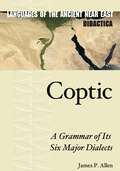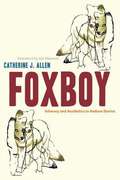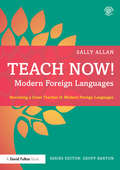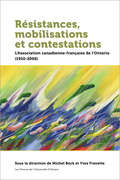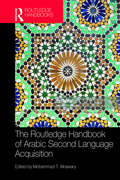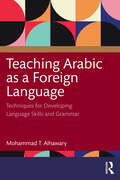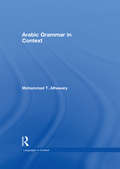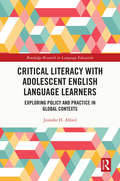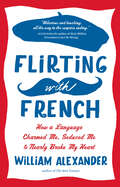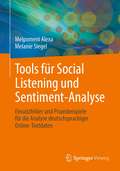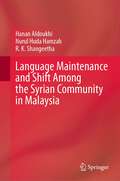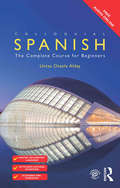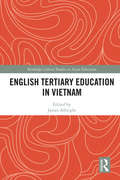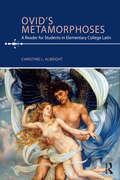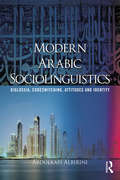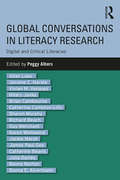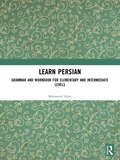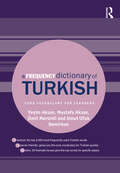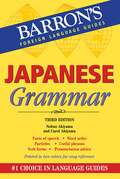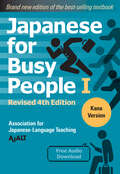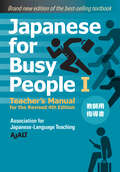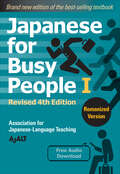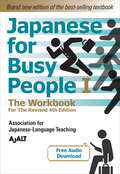- Table View
- List View
Coptic: A Grammar of Its Six Major Dialects (Languages of the Ancient Near East Didactica)
by James P. AllenCoptic is the final stage of the ancient Egyptian language, written in an alphabet derived primarily from Greek instead of hieroglyphs. It borrows some vocabulary from ancient Greek, and it was used primarily for writing Christian scriptures and treatises. There is no uniform Coptic language, but rather six major dialects.Unlike previous grammars that focus on just two of the Coptic dialects, this volume, written by senior Egyptologist James P. Allen, describes the grammar of the language in each of the six major dialects. It also includes exercises with an answer key, a chrestomathy, and an accompanying dictionary, making it suitable for teaching or self-guided learning as well as general reference.
Foxboy
by Catherine J. AllenOnce there was a Quechua folktale. It begins with a trickster fox’s penis with a will of its own and ends with a daughter returning to parents who cannot recognize her until she recounts the uncanny adventures that have befallen her since she ran away from home. Following the strange twists and turnings of this tale, Catherine J. Allen weaves a narrative of Quechua storytelling and story listening that links these arts to others—fabric weaving, in particular—and thereby illuminates enduring Andean strategies for communicating deeply felt cultural values. In this masterful work of literary nonfiction, Allen draws out the connections between two prominent markers of ethnic identity in Andean nations—indigenous language and woven cloth—and makes a convincing case that the connection between language and cloth affects virtually all aspects of expressive culture, including the performing arts. As she explores how a skilled storyteller interweaves traditional tales and stock characters into new stories, just as a skilled weaver combines traditional motifs and colors into new patterns, she demonstrates how Andean storytelling and weaving both embody the same kinds of relationships, the same ideas about how opposites should meet up with each other. By identifying these pervasive patterns, Allen opens up the Quechua cultural world that unites story tellers and listeners, as listeners hear echoes and traces of other stories, layering over each other in a kind of aural palimpsest.
Teach Now! Modern Foreign Languages: Becoming a Great Teacher of Modern Foreign Languages (Teach Now!)
by Sally AllanBeing taught by a great teacher is one of the great privileges of life. Teach Now! is an exciting new series that opens up the secrets of great teachers and, step-by-step, helps trainees to build the skills and confidence they need to become first-rate classroom practitioners. Written by a highly-skilled practitioner, this practical, classroom-focused guide contains all the support you need to become a great modern foreign languages teacher. Combining a grounded, modern rationale for learning and teaching with highly practical training approaches, the book guides you through all the different aspects of MFL teaching offering clear, straightforward advice on classroom practice, lesson planning and working in schools. Teaching and learning, planning, assessment and behaviour management are all covered in detail, with a host of carefully chosen examples used to demonstrate good practice. There are also chapters on the essentials of the MFL curriculum, pedagogical techniques, strategies to engage students in language learning, and how to succeed in observations and interviews. Throughout the book, there is a great selection of ready-to-use activities, approaches and techniques which will help put you on the fast track to success in the classroom. Covering everything you need to know, this book is your essential guide as you start your exciting and rewarding career as an outstanding MFL teacher.
Résistances, mobilisations et contestations: L’Association canadienne-française de l’Ontario (1910-2006) (Collection Amérique française)
by Gratien Allaire Serge Dupuis Mariève Forest Anne Gilbert Marcel MartelL’Association canadienne-française de l’Ontario (ACFO) a été le principal porte-parole politique de la collectivité franco-ontarienne au XXe siècle. Cette analyse historique en six chapitres chronologiques va de la fondation de l’Association canadienne-française d’éducation d’Ontario (ACFEO) en 1910 jusqu’à sa disparition et son absorption par l’Assemblée de la francophonie de l’Ontario en 2006. De 1910 à 1927, l’Association joue un rôle déterminant dans la crise du Règlement 17, qui interdit l’enseignement en français dans les écoles de la province. De 1927-1969, l’ACFEO contribue activement à l’avancement de la cause des écoles françaises (ou « bilingues ») de l’Ontario. Entre 1969 et 1982, l’Association, devenue l’« ACFO », travaille aux progrès institutionnels de la collectivité franco-ontarienne, tout en essuyant des critiques, voire des dénonciations formulées par plusieurs groupes de militants animés par les idéologies contre-culturelle et participative alors en vogue. Entre 1982 et 1992, l’ACFO se redéfinit pour s’adapter à la transformation de l’espace politique de l’Ontario français, ainsi qu’à la fragmentation de son champ idéologique sous l’impulsion de plus en plus irrépressible des régionalismes identitaires et de l’arrivée de groupes ethnoculturels issus de l’immigration francophone. Les années 1992-2006 sont les dernières de l’ACFO, qui ne peut se relever de la crise de légitimité qui la mine depuis la fin des années 1970. Une fenêtre privilégiée sur les efforts de construction identitaire et politique de la francophonie ontarienne au XXe siècle. Ce livre est publié en français. - The French-Canadian Association of Ontario (ACFO) has been the main political voice person for the Franco-Ontarian community in the 20th century. The first chapter (1910-1927) examines the first years of the Association and delves into the pivotal role it played during the debate surrounding Regulation 17, which was designed to prevent French-language schooling in the province. From 1927-1969, the ACFEO actively contributed to the advancement of French (or “bilingual”) schools in Ontario. From 1969-1982, the Association, now called ACFO, played a key role in the institutional progress of the Franco-Ontarian community, amidst much criticism and accusations made by militants inspired by the counter-culture and participative ideologies of the day. From 1982 to 1992, ACFO redefined itself in order to adapt to an evolving political situation in l’Ontario français, as well as to the fragmentation of its ideology as regional identities took shape to a new ethnocultural reality in the wake of francophone immigration. The years from 1992 to 2006 were the Association’s last, as it became unable to overcome a legitimacy crisis that had been undermining it since the end of the 1970s. A glimpse into the efforts that went into the identity and political construct of the Ontarian Francophonie throughout the 20th century. This book is published in French.
Romance Languages
by Ti Alkire Carol RosenTi Alkire and Carol Rosen trace the changes that led from colloquial Latin to five major Romance languages, those which ultimately became national or transnational languages: Spanish, French, Italian, Portuguese, and Romanian. Trends in spoken Latin altered or dismantled older categories in phonology and morphology, while the regional varieties of speech, evolving under diverse influences, formed new grammatical patterns, each creating its own internal regularities. Documentary sources for spoken Latin show the beginnings of this process, which comes to full fruition in the medieval emergence of written Romance languages. This book newly distills the facts into an appealing program of study, including exercises, and makes the difficult issues clear, taking well motivated and sometimes innovative stands. It provides not only an essential guide for those new to the topic, but also a reliable compendium for the specialist.
Routledge Handbook of Arabic Second Language Acquisition (Routledge Language Handbooks)
by Mohammad T. AlhawaryThe Routledge Handbook of Arabic Second Language Acquisition introduces major current approaches in Arabic second language acquisition (SLA) research and offers empirical findings on crucial aspects and issues to do with the learning of Arabic as a foreign language and Arabic SLA. It brings together leading academics in the field to synthesize existing research and develops a new framework for analyzing important topics within Arabic SLA. This handbook will be suitable as a reference work for advanced undergraduate and postgraduate students and scholars actively researching in this area and is primarily relevant to sister disciplines within teacher training and Arabic applied linguistics. The themes and findings should, however, also be attractive to other areas of study, including theoretical linguistics, psycholinguistics, cognition, and cognitive psychology.
Teaching Arabic as a Foreign Language: Techniques for Developing Language Skills and Grammar
by Mohammad T. AlhawaryTeaching Arabic as a Foreign Language: Techniques for Developing Language Skills and Grammar is an indispensable guide for in-training and novice teachers of Arabic as a foreign language and a source of fresh and effective ideas for experienced teachers. This highly practical guide outlines how Arabic second-language skills (listening, speaking, reading, and writing) and grammar are targeted in isolation from one another and how they are integrated to reinforce each other through the use of specific tried-and-tested techniques and activities. Teaching Arabic as a Foreign Language provides instantly accessible, practical teaching techniques to target and develop specific language skills and grammar at novice, intermediate, and advanced levels.
Arabic Grammar in Context (Languages in Context)
by Mohammad AlhawaryArabic Grammar in Context offers a unique and exciting approach to learning grammar. It presents grammar as a necessary and essential tool for understanding Arabic and for developing comprehension and production skills. Features include: authentic texts from a rich variety of sources, literary and non-literary, used as the starting point for the illustration and explanation of key areas of Arabic grammar clear and authoritative demonstration of the relevance of grammar for understanding and interpreting Arabic a wide range of appropriate exercises designed to consolidate learning fully vocalized exercises and texts a glossary of vocabulary and expressions provided at the end of the book audio readings of the texts available online for additional listening practice. Suitable for class use and independent study, Arabic Grammar in Context is ideal for intermediate to advanced learners of Arabic.
Critical Literacy with Adolescent English Language Learners: Exploring Policy and Practice in Global Contexts (Routledge Research in Language Education)
by Jennifer AlfordThis book examines critical literacy within language and literacy learning, with a particular focus on English as an Additional Language learners in schools who traditionally are not given the same exposure to critical literacy as native-English speakers. An important and innovative addition to extant literature, this book explains how English language teachers understand critical literacy and enact it in classrooms with adolescent English language learners from highly diverse language backgrounds. This book brings together the study of two intersecting phenomena: how critical literacy is constructed in English language education policy for adolescent English language learners internationally and how critical literacy is understood and enacted by teachers amid the so-called ‘literacy crisis’ in neoliberal eduscapes. The work traces the ways critical literacy has been represented in English language education policy for adolescents in five contexts: Australia, England, Sweden, Canada and the United States. Drawing on case study research, it provides a comparative analysis of how policy in these countries constructs critical literacy, and how this then positions critical engagement as a focus for teachers of English language learners. Empirically based and accessibly written, this timely book will be of interest to a wide range of academics in the fields of adolescent literacy education, English language learning and teaching, education policy analysis, and critical discourse studies. It will also appeal to teachers, post-graduate students and language education policy makers.
Flirting with French: How a Language Charmed Me, Seduced Me, and Nearly Broke My Heart
by William Alexander“A delightful and courageous tale and a romping good read. Voila!” —Mark Greenside, author of I’ll Never Be French (No Matter What I Do) William Alexander is more than a Francophile. He wants to be French. There’s one small obstacle though: he doesn’t speak la langue française. In Flirting with French, Alexander sets out to conquer the language he loves. But will it love him back? Alexander eats, breathes, and sleeps French (even conjugating in his dreams). He travels to France, where mistranslations send him bicycling off in all sorts of wrong directions, and he nearly drowns in an immersion class in Provence, where, faced with the riddle of masculine breasts, feminine beards, and a turkey cutlet of uncertain gender, he starts to wonder whether he should’ve taken up golf instead of French. While playing hooky from grammar lessons and memory techniques, Alexander reports on the riotous workings of the Académie française, the four-hundred-year-old institution charged with keeping the language pure; explores the science of human communication, learning why it’s harder for fifty-year-olds to learn a second language than it is for five-year-olds; and, frustrated with his progress, explores an IBM research lab, where he trades barbs with a futuristic hand-held translator. Does he succeed in becoming fluent? Readers will be as surprised as Alexander is to discover that, in a fascinating twist, studying French may have had a far greater impact on his life than actually learning to speak it ever would. “A blend of passion and neuroscience, this literary love affair offers surprise insights into the human brain and the benefits of learning a second language. Reading William Alexander’s book is akin to having an MRI of the soul.” —Laura Shaine Cunningham, author of Sleeping Arrangements “Alexander proves that learning a new language is an adventure of its own--with all the unexpected obstacles, surprising breakthroughs and moments of sublime pleasure traveling brings.” —Julie Barlow, author of Sixty Million Frenchmen Can’t Be Wrong
Tools für Social Listening und Sentiment-Analyse: Einsatzfelder und Praxisbeispiele für die Analyse deutschsprachiger Online-Textdaten
by Melpomeni Alexa Melanie SiegelMit diesem Buch lernen Sie, wie Sie Social Listening und Sentiment-Analyse professionell einsetzen können. Der Leser erhält Schritt-für-Schritt-Beschreibungen für verschiedene Einsatzszenarien, gekoppelt mit Übungsaufgaben und nützlichen Materialien, darunter ein Merkblatt für Kennzahlen, eine Checkliste für die Toolauswahl und ein Glossar für Fachbegriffe. Dieses Lehr- und Praxisbuch verdeutlicht anhand von Anwendungsszenarien und Praxisbeispielen, wie Tools und Technologien für Social Listening und Sentiment-Analyse für die Analyse deutschsprachiger Online-Textdaten angewandt werden können und welche Vorteile diese bringen. Der Leser erhält einen Überblick über wichtige Funktionalitäten aktuell verfügbarer Social-Listening-Tools und deren Einsatzmöglichkeiten.
Language Maintenance and Shift Among the Syrian Community in Malaysia
by Hanan Aldoukhi Nurul Huda Hamzah R. K. ShangeethaThis book investigates language choices in different domains among Syrian Arab Muslim families who came to Malaysia after war broke out in their country. It focuses on how Syrian Heritage Language (HL), Modern Standard Arabic (MSA), Classical Arabic (CA), and other languages that might be spoken by these families were maintained and/or shifted from the time these families came to Malaysia until the lockdown due to the COVID-19 pandemic. Most works on Syrian community in Malaysia are focused on social and humanitarian issues; none has explored how Syrians in Malaysia are managing their language use in connection with day-to-day communication and integration. As the Syrian community in Malaysia adapts by learning the host language, their mother language/s might experience a shift. The way the minority communities view their mother language by prioritizing or deprioritizing its use in the family milieu are factors that contribute to language maintenance and language shift (LMLS). As such, this book provides insights on how Syrian parents are managing their own and their children’s language/s, along with the language of the host country.
Colloquial Spanish: The Complete Course for Beginners (The\colloquial Ser.)
by Untza Otaola AldayColloquial Spanish: The Complete Course for Beginners has been carefully developed by an experienced teacher to provide a step-by-step course to Spanish as it is written and spoken today. Combining a clear, practical and accessible style with a methodical and thorough treatment of the language, it equips learners with the essential skills needed to communicate confidently and effectively in Spanish in a broad range of situations. No prior knowledge of the language is required. Colloquial Spanish is exceptional; each unit presents a wealth of grammatical points that are reinforced with a wide range of exercises for regular practice. A full answer key, a grammar summary, bilingual glossaries and English translations of dialogues can be found at the back as well as useful vocabulary lists throughout. Key features include: A clear, user-friendly format designed to help learners progressively build up their speaking, listening, reading and writing skills Jargon-free, succinct and clearly structured explanations of grammar An extensive range of focused and dynamic supportive exercises Realistic and entertaining dialogues covering a broad variety of narrative situations Helpful cultural points explaining the customs and features of life in Spain An overview of the sounds of Spanish Balanced, comprehensive and rewarding, Colloquial Spanish is an indispensable resource both for independent learners and students taking courses in Spanish. Audio material to accompany the course is available to download free in MP3 format from www.routledge.com/cw/colloquials. Recorded by native speakers, the audio material features the dialogues and texts from the book and will help develop your listening and pronunciation skills.
English Tertiary Education in Vietnam (Routledge Critical Studies in Asian Education)
by James AlbrightAs part of a long series of Vietnam’s policy objectives, English education has been identified as key to improving the quality of its rapidly expanding tertiary institutions and is crucial to the larger aim of modernising and internationalising its economy. Bringing together a wide range of Vietnamese and foreign English education scholars, and tertiary educational practitioners, this book documents the significant progress and challenges in the realisation of Vietnam’s English language policies as they are enacted in the higher education sector. Changes to Vietnam’s higher education system remain unstable, unsystematic, and insubstantial. This book provides insights into how recent Vietnamese government policy is providing for a substantial and comprehensive renewal of Vietnam’s tertiary education as part of their 2020 plan. Academics and students of English education, language policy, and nation building within the context of increased globalisation and marketisation in developing nations and Vietnam, in particular, should find this book valuable.
Ovid's Metamorphoses: A Reader for Students in Elementary College Latin
by Christine L. AlbrightOvid’s Metamorphoses is a Latin reader designed to partner existing elementary Latin textbooks. The book features thirty compelling stories, graduated in difficulty and adapted from Ovid’s epic Metamorphoses into prose. The original poem contains many different stories united thematically by the transformation which occurs in all of them; the epic features romance, seduction, humour, violence, monsters, and misbehaving gods. Each chapter contains: a Latin passage adapted from the epic an accompanying vocabulary list a short commentary to help with translation a concise review of the specific grammar covered a brief comment on a literary aspect of the poem, or featured myth. A free companion website, offering a wealth of additional resources, including worksheets, flashcards, additional notes for each chapter, and audio, is available at www.routledge.com/cw/albright. Suitable for college students studying Latin at the elementary level, Ovid’s Metamorphoses is designed to be used alongside elementary Latin textbooks. Preserving Ovid’s language and highly vivid descriptions, this reader introduces students to the epic masterpiece, allows them to consolidate their understanding of Latin prose, and offers opportunities for literary discussion.
Modern Arabic Sociolinguistics: Diglossia, variation, codeswitching, attitudes and identity
by Abdulkafi AlbiriniModern Arabic Sociolinguistics outlines and evaluates the major approaches and methods used in Arabic sociolinguistic research with respect to diglossia, codeswitching, language variation and attitudes and social identity. This book: outlines the main research findings in these core areas and relates them to a wide range of constructs, including social context, speech communities, prestige, power, language planning, gender and religion examines two emerging areas in Arabic sociolinguistic research, internet-mediated communication and heritage speakers, in relation to globalization, language dominance and interference and language loss and maintenance analyses the interplay between the various sociolinguistic aspects and examines the complex nature of the Arabic multidialectal, multinational, and multiethnic sociolinguistic situation. Based on the author’s recent fieldwork in several Arab countries this book is an essential resource for researchers and students of sociolinguistics, Arabic linguistics, and Arabic studies.
Global Conversations in Literacy Research: Digital and Critical Literacies
by Peggy AlbersIn this volume, renowned literacy and language education scholars who have shaped policy and practice aimed toward social justice and equity address current intellectual and practical issues in the teaching of literacy in classrooms and educational environments across diverse and international settings. Drawn from talks that were presented live and hosted by Global Conversations in Literacy Research (GCLR), an online open-access critical literacy project, this book provides access, in edited written form, to these scholars’ critically and historically situated talks. Bringing together talks on diverse topics—including digital and media literacy, video games, critical literacy, and ESOL—Albers preserves the scholars’ critical discourses to engage readers in the conversation. Offering a broad and expansive understanding of what literacy has to offer for scholars, teachers, and students, this book demonstrates the importance of positioning literacy as a social practice and brings critical literacy to a global audience.
State-Building and Multilingual Education in Africa
by Ericka A. AlbaughHow do governments in Africa make decisions about language? What does language have to do with state-building, and what impact might it have on democracy? This manuscript provides a longue durée explanation for policies toward language in Africa, taking the reader through colonial, independence, and contemporary periods. It explains the growing trend toward the use of multiple languages in education as result of new opportunities and incentives. The opportunities incorporate ideational relationships with former colonizers as well as the work of language NGOs on the ground. The incentives relate to the current requirements of democratic institutions, and the strategies leaders devise to win elections within these constraints. By contrasting the environment faced by African leaders with that faced by European state-builders, it explains the weakness of education and limited spread of standard languages on the continent. The work combines constructivist understanding about changing preferences with realist insights about the strategies leaders employ to maintain power.
Learn Persian: Grammar and Workbook for Elementary and Intermediate Levels
by Mahmood AlamLearn Persian has a step-by-step organized and structured framework of modern Persian words; grammar, short syntactical phrases and idiomatic expressions. Persian has a lot of common words and sounds from Arabic and Urdu; this work highlights vowels and consonants that are covered in the formation of words and sounds with apt precision. The special feature of this book is its simplicity, yet meaningful and comprehensiveness for the study of the language. This should be a good source book for new learners, as well as for those who want to explore the harmony and flair of Persian. It would undoubtedly open doors to a Persian heritage as much as it slowly trains the eager learner in spoken Persian as well. Learn Persian will interest both learners and experts, and an excellent experience of coming across Persian as an interesting living language.
A Frequency Dictionary of Turkish: Core Vocabulary For Learners (Routledge Frequency Dictionaries)
by Yeşim Aksan Mustafa Aksan Ümit Mersinli Umut DemirhanA Frequency Dictionary of Turkish enables students of all levels to build on their study of Turkish in an efficient and engaging way. <P><P> Based on a 50 million word corpus, A Frequency Dictionary of Turkish provides a list of core vocabulary for learners of Turkish as a second or foreign language. It gives the most updated, reliable frequency guidelines for common vocabulary in spoken and written Turkish. Each of the 5000 entries are supported by detailed information including the English equivalent, an illustrative example with English translation and usage statistics. The Dictionary provides a rich resource for language teaching and curriculum design, while a separate CD version provides the full text in a tab-delimited format ideally suited for use by corpus and computational linguists. With entries arranged by frequency, by suffixation and alphabetically, A Frequency Dictionary of Turkish enables students of all levels to get the most out of their study of vocabulary in an engaging and efficient way.
Japanese Grammar (Barron's Grammar Ser.)
by Nobuo Akiyama Carol AkiyamaA Simon & Schuster eBook. Simon & Schuster has a great book for every reader.
Japanese for Busy People Book 1: Revised 4th Edition (Japanese for Busy People Series)
by AJALT4th Revised Edition of JAPANESE FOR BUSY PEOPLE, the most popular Japanese language textbook series in the world. Since it was first published in 1984, the focus of the Japanese for Busy People series has always been to teach Japanese for effective communication. As suggested in the title, this is a concise course for busy students who want to learn natural, spoken Japanese as efficiently as possible in a limited amount of time. The new Japanese for Busy People: Revised 4th Edition is made up of three volumes: Book I, Book II, and Book III. Book I is available in both romanized and kana versions, similar to the Revised 3rd Edition. The Kana Version is exactly the same as the Romanized Version except for the scripts used throughout the book: hiragana and katakana. The Kana Version is therefore recommended for those who have already learned kana (as these scripts are collectively called) or are learning them with Japanese for Busy People Kana Workbook or another such text. Studying Japanese in kana, rather than in romanized script, can lead to fluent pronunciation and facilitate a smooth transition to the study of kanji.
Japanese for Busy People Book 1: Revised 4th Edition (Japanese for Busy People Series)
by AJALTJapanese for Busy People is the most popular Japanese language textbook series in the world. Japanese for Busy People series is one of the most comprehensive series containing texts, workbooks and teacher&’s manuals for all three volumes. Audio recordings for the dialogues and listening exercises are now available as free download from kodansha.us. Teacher&’s Manual provides specific suggestions for teachers on how to use the main text in a classroom setting and how to coordinate it with the workbook. CAN-DO section is useful in creating lesson plan and measuring learners&’ mastery level. It also contains a Japanese translation of all of the key components of the main text, such as culture notes, notes on Japanese grammar, and active communication. This first of three volumes introduces "survival Japanese" — the absolute minimum amount of Japanese needed to live in Japan. Thus, the vocabulary and grammatical items it introduces are limited to about a third of what is typically introduced in a first-year course. In addition, the book features notes on Japanese culture intended to expand the learner&’s understanding of Japan, its customs and people. Japanese for Busy People I is available in two formats: romanized and kana. The Romanized Version uses romanized Japanese throughout, with kana in the Opening Dialogues of each lesson. The Kana Version — exposing students to hiragana and katakana from the very beginning — uses only kana.The content of the two books is otherwise exactly the same. The companion volume, Japanese for Busy People 1: The Workbook for the Revised 4th Edition contains a variety of illustrated exercises for mastering the basic sentence patterns presented in the main text.
Japanese for Busy People Book 1: Revised 4th Edition (Japanese for Busy People Series)
by AJALT4th Revised Edition of JAPANESE FOR BUSY PEOPLE, the most popular Japanese language textbook series in the world.Since it was first published in 1984, the focus of the Japanese for Busy People series has always been to teach Japanese for effective communication. As suggested in the title, this is a concise course for busy students who want to learn natural, spoken Japanese as efficiently as possible in a limited amount of time.The new Japanese for Busy People: Revised 4th Edition is made up of three volumes: Book I, Book II, and Book III. Book I is available in both romanized and kana versions, similar to the Revised 3rd Edition.The Romanized Version uses romanized Japanese throughout, with kana in the Target Dialogues of each lesson.
Japanese for Busy People Book 1: Revised 4th Edition (Japanese for Busy People Series)
by AJALT4th Revised Edition of JAPANESE FOR BUSY PEOPLE, the most popular Japanese language textbook series in the world. Since it was first published in 1984, the focus of the Japanese for Busy People series has always been to teach Japanese for effective communication. Japanese for Busy People I: The Workbook for the Revised 4th Edition is for all learners who wish to improve their speaking and listening skills. It can be used in tandem with Japanese for Busy People I: Revised 4th Edition, both Kana Edition and Romanized Edition, or as independent study material. The workbook provides ample speaking and listening practice in the form of illustrated exercises that call on learners to construct dialogues and role-play in Japanese. Illustrations combined with conversations, which proceed at a natural pace in the audio recordings, help learners to feel as if they are actually experiencing each situation. Through repeated oral and listening practice, learners will come to acquire the rhythm of real-life Japanese conversation. Audio recordings can be downloaded for free from kodansha.us.
